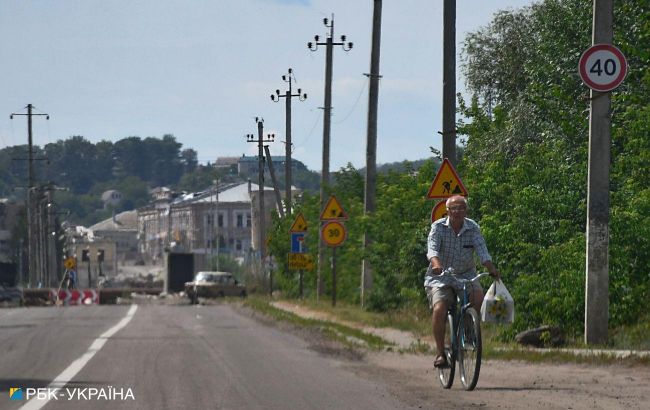A step away from the frontline: How Kupiansk holds defense and remembers horrors of Russian occupation
 Kupiansk remembers the horrors of Russian occupation (Photo: Anastasiia Rokytna, RBC-Ukraine)
Kupiansk remembers the horrors of Russian occupation (Photo: Anastasiia Rokytna, RBC-Ukraine)
While the troubled city in the Kharkiv region, Kupiansk, is still recovering from the previous occupation regime, the Russian army is attempting to reach the city once again. The situation in the city, including constant shelling and the enemy's attempts to advance - in the report by RBC-Ukraine.
Kupiansk returns to the spotlight due to the concentration of Russian forces in this direction. While our troops continue heavy counteroffensive actions on the southeastern front, the enemy seeks to expand the hot frontline. Today, the distance from the city to the frontline is approximately ten kilometers, akin to the stretch from Chasiv Yar to Bahmut. Each day, Kupiansk bears the brunt of heavy attacks from Russian artillery, multiple-launch rocket systems, and missiles. Have the Ukrainian forces prepared a response to these relentless assaults, and is there a looming threat of Kupiansk falling under occupation once again?
***
Civilization doesn't end abruptly. Despite the asphalt road being damaged from tank movements, it doesn't appear as ancient as one might expect. Eight hours from Kyiv, the road leads to the liberated Kharkiv region, free from occupation. Unlike the battered paths of Donetsk and Luhansk, where war has persisted for nine years, here, traces of life and vibrant infrastructure are evident in the renewed road signs, modernized building repairs, and smooth asphalt. However, they still bear the scars of bullets, rockets, and artillery shells. And each day, those scars grow deeper.
Just a step away from the frontline, Kupiansk is now facing a second Russian onslaught. For six months, the city was under occupation during the initial large-scale invasion until Ukrainian forces liberated it in September after intense battles on the left bank of the city. The consequences of those strikes are still visible today, with every subsequent shattered building, bridge, or gas station in this part of Kupiansk.
As we approach, another strike from enemy artillery hits an industrial area, leaving a dark cloud of smoke in the air. After a few minutes, outgoing fire is heard – it's the Ukrainian forces retaliating against the new scar of the "Russian world" on Ukrainian territory.
Active combat continues just ten kilometers from the city, with the enemy continuing to deploy troops and equipment in this direction. "On the left bank, there are several populated areas, and Kupiansk is strategically important. That's where the enemy is advancing. Currently, the frontline runs through forests, down from the villages of Dvorichne and Masyutivka," explains a military serviceman Maksym.
 Maksym started his military journey as a volunteer in 2014 when the Ukrainian army was vastly different from what it is today. Perhaps the Russians banked on this disparity when they launched their full-scale invasion in 2022. However, the unexpected factor was the Ukrainian Armed Forces, who managed to halt the Russian occupiers' breakthrough. Maksym had fought in the Donetsk region and now his unit has been redeployed to Kupiansk, where, according to him, the intensity of combat has significantly increased after the de-occupation.
Maksym started his military journey as a volunteer in 2014 when the Ukrainian army was vastly different from what it is today. Perhaps the Russians banked on this disparity when they launched their full-scale invasion in 2022. However, the unexpected factor was the Ukrainian Armed Forces, who managed to halt the Russian occupiers' breakthrough. Maksym had fought in the Donetsk region and now his unit has been redeployed to Kupiansk, where, according to him, the intensity of combat has significantly increased after the de-occupation.
Kupiansk itself is home to around 12,000 residents, who enjoy all the municipal services – communication, electricity, and water. However, these services are becoming increasingly disrupted as attacks on the city grow more frequent, taking a toll on civilian lives. Today, another tragic incident occurred as a 57-year-old woman lost her life due to a strike on a residential building.
The military administration of the region reveals that in recent days, the enemy has intensified shelling on Kupiansk and its neighboring settlements near the frontline. Yesterday, prior to our arrival, Krasne Pershe, Novomlynsk, Novoosinove, and Synkivka were under heavy artillery and mortar fire.

During our trip, there were several bombings. According to local authorities, these strikes caused damage to the feed mill facility, at least four private residential houses, and agricultural structures. Since the invasion began in this region, a total of 202 people have lost their lives, including 77 children.
Currently, an evacuation of the population is underway. People are receiving humanitarian and material aid, and those in need are being provided with temporary shelter in relatively safe areas.
"In the spring of this year, we declared a mandatory evacuation of children from the Kupiansk community, which was completed in May. We evacuated the last 79 children from the area of constant shelling. Currently, there are no children in dangerous settlements in the Kupiansk region," stated the press service of the Kharkiv Regional Military Administration.
As we drive through the city, we indeed do not see children. There are more elderly people left, those who have nowhere else to go. The looks from the city's residents are wary of the new "visitors." Some of these residents stayed in Kupiansk during the occupation when Russian forces held control.
The locals here are not very talkative, a common trait among many liberated areas we've visited. This city is no exception. They avoid answering journalists' questions, often claiming they are "in a hurry." Nevertheless, we managed to speak with one man.
 Oleh was born here, having lived here almost all his life, rarely traveling outside except to Kharkiv. He says they lived well before the Russian invasion, and "no one knew sorrow." But now, it's like living like a powder keg every day, not knowing what tomorrow will bring.
Oleh was born here, having lived here almost all his life, rarely traveling outside except to Kharkiv. He says they lived well before the Russian invasion, and "no one knew sorrow." But now, it's like living like a powder keg every day, not knowing what tomorrow will bring.
"They (Ukrainian Armed Forces - Ed.) had just driven the Russians out of the city, and now they are creeping back again. What do they want from us? Let them establish order in their own territories. Why meddle in what is not yours? We miraculously survived here. The Russians conducted serious purges. And just when we thought we could live on, they started shelling us again. I hope the Ukrainian Armed Forces won't allow them to come to our land a second time," shares Oleh, but he asks not to be photographed.
At that moment, we notice a woman nearby who suspiciously looks at Oleh, as if he said something unnecessary.
– And what do you think about this? – we ask her.
– I'm for peace. They should stop shooting at each other; we want peace.
– But you understand that Russia attacked Ukraine, which is now reclaiming territories from the occupation, defending you, right? It's the opposite.
– I don't understand these things, – the woman said and hurried away.
The population in every eastern region is divided into those who are "for Ukraine" and those who expect the "Russian world." The latter doesn't seek it in a state with a corresponding name but promotes the ideas of the Putin regime on Ukrainian territory. Their lack of understanding of the Russian-Ukrainian war clearly characterizes this segment of the population. They are not even deterred by the news that almost half of those killed in the region are children.
In addition, the troops currently stationed in the area say that although the enemy forces have made some advancements, their offensive has been halted, and the Ukrainian forces are gradually pushing forward.
"There is currently no threat to Kupiansk, as there is a natural barrier - the Oskol River. It's harder to settle there. A month ago, it was still calm: you release 20 mines at them (Russians - Ed.), and they fire back with 3. But they started accumulating resources. About a week ago, they launched more active operations from their side," said Maksym.
According to the military serviceman, Kupiansk is strategically important for the Lyman direction. The Russians have long aimed to capture Donetsk and Luhansk regions, and they continue to prioritize these objectives. Moreover, the railway leading to Russia remains crucial, as it was used by the Russians to transport supplies during the occupation to the Izium direction.
Today's Russian offensive also has tactical aims: to draw the Ukrainian forces away from Bakhmut and slow down Ukraine's counteroffensive. This was similarly seen during the Kahovka HPP incident when the Russians blew up the station in an attempt to influence the liberation of the southern region from the occupiers.
Russian sources may exaggerate Russia's success and the Ukrainian forces' offensive actions along the Kupiansk-Svatove-Kreminna line to depict Ukraine's ongoing counteroffensive as a failure. This opinion was expressed by analysts from the American Institute for the Study of War (ISW). However, visual evidence of such claims from Russia is lacking.
While Ukrainian soldiers have a slightly different perspective on the advancement of Russian forces, they are currently repelling those territories that will eventually be liberated from the Russian invasion, just like all other occupied regions of Ukraine. As we speak about this, the sun rises, casting Kupiansk in dark red rays. We say goodbye with the hope that the frontline will move away from this region soon, bringing peace and the reconstruction of a city liberated from the occupiers.

